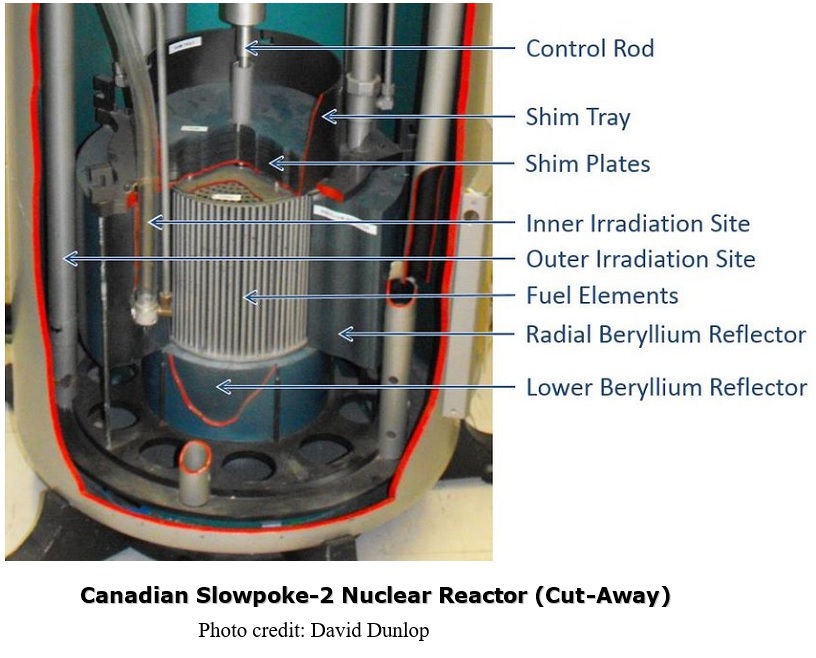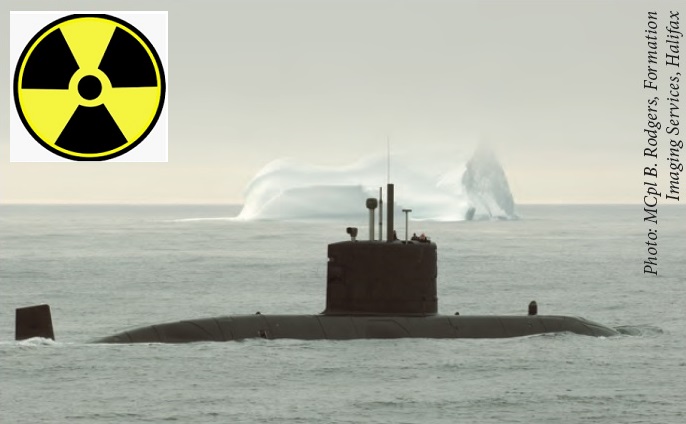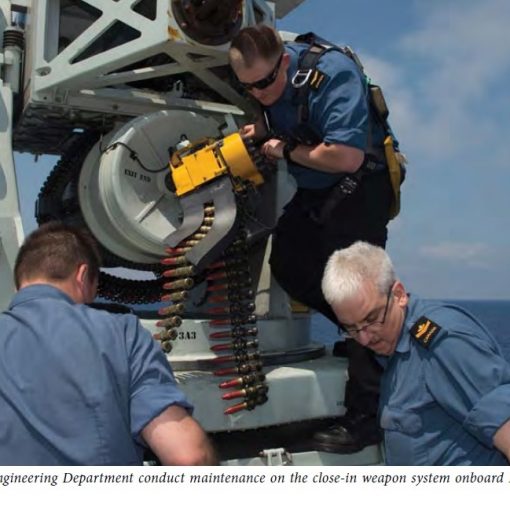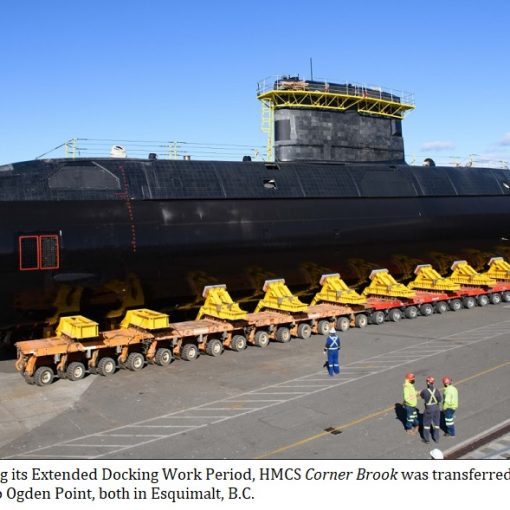David Dunlop, 28 February 2020.
Nuclear propulsion of submarines is ideal for long distances and extended under-ice missions. But is there a better, more affordable and collaborative way? Off-the-shelf air-independent propulsion (AIP) submarines such as the French Barracuda Block 1A class being designed for Australia or the Japanese Soyru-class AIP design with lithium ion battery (LIB) technology are alternatives that extend the endurance of diesel submarines. But neither of these options are completely satisfactory for Canadian submarine needs. The dominant paradigm for a modern nuclear-powered submarine is a steam generating reactor driving turbines that directly drive the propeller. The French Shortfin Barracuda Block 1A being built for Australia offers a limited hybrid design that enables electric propulsion for low-speed cruising and turbo-mechanical drives at higher speeds, but is not competitive against nuclear-steam turbo-mechanical for blue water or Arctic operations.
Outrageous cost estimates for nuclear-powered submarines tend to cloud Canadian thinking about recapitalizing the submarine fleet. DND’s proposal for extending the lives of Canada’s four Victoria-class conventional submarines for another 6-18 years appears to be a bargain. But is there a better way? The first challenge to costs is volume. Development, or non-recurring engineering costs, make up a sizable percentage of the cost of a small fleet of subs. If an existing, proven, hull can be slightly modified, it is a major cost saver. That will require DND to end the habit of imposing onerous modifications that inevitably cause costs to explode. Another route to substantial cost savings is to share the development costs of major items like the propulsion and power plant with partners.
Technologies like AIP or LIBs extend the endurance of diesel submarines but introduce major compromises in performance. But neither of these options are satisfactory for Canadian naval requirements. With or without AIP, diesels are far too ‘short legged’ – they are dependent on logistically complex supplies such as liquid oxygen that deplete quickly; and the engines are mechanically complex. These are distinct disadvantages given the long distances missions that Canadian subs must undertake.
Whenever a diesel ‘snorts,’ it leaves a very visible plume of smoke and heat that is readily detectable. Radar can pick out periscopes or snorkels. Then there is the deafening noise of diesels, even when equipped with the latest quieting technologies. Thus, nuclear propulsion in some form is still the ideal for Canadian requirements. Due to their endurance, nuclear submarines tend to be blue water, ocean-going, and compared to the Victoria-class at about 2,500 tons, they are large vessels. A fleet nuclear submarine is neither necessary nor ideal for Canadian waters. A smaller nuclear-powered attack submarine that is large enough to support a good sized crew and carry unmanned systems would be ideal for Canada but, presently, none is available.
A hybrid submarine offers a novel solution. A fleet of hybrid nuclear submarines (6,000+ ton range) would be ideal for Canada. But building such a submarine with this kind of displacement with a 60 day endurance, transit speeds of 20 knots, burst speeds above 30 knots, state-of-the-art signature management technologies and support for unmanned platforms would be cost prohibitive for all but the largest navies. Canada does, however, have an excellent technology that can contribute to a joint venture with, say, the USA, France or Japan for a new hybrid nuclear/AIP submarine design – the Canadian Safe LOW POwer (K) Critical Experiment, or ‘Slowpoke-2’ reactor. This would be just about ideal for a smaller nuclear-powered/AIP submarine. A nuclear, battery-electric hybrid is a potentially attractive alternative to the dominant nuclear turbo-mechanical drive. One or more modular reactors can be used to generate power to drive generators or constantly top-up LIBs.

The ability to completely shut down a reactor module, and match energy demand with supply, reduces the amount of excess (waste) heat dumped – don’t forget, that heat dump is detectable. Machinery noise from the nuclear turbo-mechanical generator can be more readily controlled if the system is operated at (and optimized for) a relatively narrow power band with no requirements for rapid throttling as with a turbo-mechanical drive. Electricity generated can be stored in state-of-the-art LIBs. Reactor shielding can potentially make use of lead acid cells doing double duty. Electric power from batteries driving propulsors offer the prospect of extremely low radiated noise and yet maintain a high degree of ‘throttlability’ with only limited compromises in sustained high-speed cruising that would be a function of the nuclear plant’s power ramp and maximum output. Making the propulsor jets steerable and eliminating control fins is an additional benefit in minimizing the active signature.
One of the biggest advantages of Slowpoke-2 reactors in a modern hybrid AIP submarine design is that ‘snorting’ of the submarine would be a thing of the past as energy would be continually stored in LIBs for better under-ice endurance. This would also open up potential lucrative markets for this Canadian nuclear technology.
During the mid-1980s Canada briefly considered converting its Oberon-class submarines to nuclear power using a Slowpoke-1 nuclear reactor to continuously recharge the ship’s batteries during submerged operations. The Slowpoke-2 design is a larger, improved version of the Slowpoke-1 reactor. The upgraded design has a high ratio of neutron production to fission power, with a nominal power level of 20 kWA. A good deal of work has been done on potential marine applications of the reactor at Royal Military College in Kingston Ontario. The main advantages of the Slowpoke-2 reactor is the reliability and ease of use of this design. The Slowpoke-2 is small enough and inexpensive enough to make it accessible for smaller submarines. It is the only type of nuclear reactor licensed in Canada for unattended operation in automatic mode. In 2001 the Slowpoke-2 digital Integrated Reactor Control and Instrumentation System (SIRCIS) was implemented using professional development software. SIRCIS increased the functionality of the original analog system and improved the overall user interaction.
Who might partner with Canada? France, Japan and Australia are all potential partners. Each state’s existing or planned submarine designs are potentially good candidates. In fact, the French are already working on a new hybrid Barracuda variant for Australia. A collaboration with Japan, which has begun work on its next generation of electric Soryu-class AIP submarines, could contribute certain technologies like LIBs in which Japan excels.
If Canada contributed a major portion of the development costs of modular Slowpoke-2 power plants for hybrid submarines, it could be used to negotiate a better price on the subs, perhaps less than 1B CAD per sub (substantially lower than any standard nuclear sub being built today). It will also be the only small naval reactor power plant available that can potentially be used on surface vessels like the Canadian Surface Combatant or civilian vessels. As well it could reduce greenhouse gas emissions from shipping and potentially open up lucrative markets for Canadian nuclear technology.
The question is, can such a unique hybrid sub design be built in quantity (more than 20) for less than $1B CAD a copy? The technology of the Slowpoke-2 reactor is there, and has been constantly up-graded over several decades and is on the brink of success. An updated National Shipbuilding Strategy with this innovative hybrid submarine design would be a game-changer for Canada. Faith in this program by Canadians and the government will forever banish the ghosts of the DeHavilland Avro Arrow fiasco. It will be challenging, but Canadian ingenuity is up to it.





11 thoughts on “A Canadian Hybrid Submarine Design: A Case for the Slowpoke-2 Reactor”
Interesting article to open the debate for a Canadian nuclear submarine. While I might like the idea of a so-called hybrid submarine, it is not new, all nuclear submarines include batteries and even diesel generators for emergency. Indeed new French Suffren SSN, first Barracuda-class boat, seems to use a nuclear reactor along with electric drive (2x turbo alternateurs, 10MW, according to fr.wikipedia).
Out of the many elements to be considered in the design of a nuclear boat, I will point to only one of them: What is the maximum speed expected in ‘nuclear mode’? Usually the answer is something like ‘as much as (reasonably) possible,’ but this is related to the available power and submerged displacement of the submarine. French Barracuda-class (5,300 tons) needs about 10 MW to reach 23 knots. British Astute-class (7,400 tons) needs about 25 to 30 MW to reach 30 knots. Let’s consider the smallest option, i.e., a 5,300 tonne submarine. Whichever reactor is to be used, she would need about 3.3 MW to make 16 knots and about 6 MW (6,000 kW) to reach 20 knots. This is 165 to 300 times the power of the Slowpoke-2 reactor.
Higher speeds may be available by using batteries and electric motors, but only for some hours, not days. Alternatively, at low speeds (4 to 6 knots) lithium-ion (Li-ion) batteries as fitted in the latest Soryu-class would last for several days, up to around one week, but not more than two weeks.
We may refer to previous experiences in Canada dated from the late 1980s (see link 1 below). The AMPS 1000 project consisted of a pressure water reactor (PWR) designed for submarine propulsion, targeted to deliver a speed of 12 knots to a 2,000 tonne boat. To achieve this, it featured a 10.8 MWt (thermal) reactor, providing 1.4 to 1.7 MWe (electric), assuming 16% efficiency in conversion. Similarly, the ‘nuclear battery’ featured 2.4 MWt, providing 0.6 MWe, assumed 25% efficiency. These are major developments compared to the Slowpoke-2 experimental reactor.
Actually 0.6 MW is twice or more the power of most of the current AIP submarines, and would allow a 5,300-tonnes submarine to transit or patrol at speeds of up to 7 knots for unlimited time. This represents an important milestone to be achieved to conduct Arctic surveillance operations under the ice.
Fortunately, the Canadian nuclear sector continues and microreactor studies for remote locations are being developed (see link 2 below). There are two PWRs mentioned there, rated 6.4 MWe and 9.0 MWe respectively. These are the type of reactors typically used in submarines. It is interesting also to note that pseudo ‘solid state,’ pump-free, heat pipe reactor technology is capable of delivering power from 0.2 to 5 MWe at low temperatures (600ºC).
However, I have a couple of questions: is it worth to re-invent the wheel? Introducing a new propulsion or reactor into an existing submarine design makes it necessary to recalculate it all again, unnecessarily increasing costs and project risks. That’s why the Australian Attack-class will need nearly 15 years from contract agreement to the delivery of the first unit. If Canada is ready to accept nuclear propulsion, would they care whether the boats have 0.6, 3, 6 or 10 MWe reactors? I believe they would be much more concerned about delivery times and cost to replace the Victoria-class.
Both Britain and France expect to finish delivery of their attack nuclear submarines (Astute and Barracuda) by late 2020s. Both are already working on their next generation SSBNs (ballistic nuclear), and will require their yards and workforce to start production as soon as they conclude their present series of SSNs. Therefore, it may be now the time to start conversations with them to check the options to stretch the series in maybe four more units for the RCN. The important point would be to ask for the minimum possible changes to the design. The more customization changes are requested, the more risks, delays and cost overruns may be expected.
On the other hand, should Canada (Defence and Procurement departments) opt to develop its own submarine, then the selected partner should demonstrate several significant capabilities beyond the one to design nuclear submarines. They should include systems integration (including combat management systems and sensors), Intellectual Property transfer contracts and proved successes in overseas collaborative projects.
Links:
http://www.iaea.org/inis/collection/NCLCollectionStore/_Public/27/011/27011663.pdf?r=1 (pages 2-8 to 2-32).
https://www.world-nuclear.org/information-library/nuclear-fuel-cycle/nuclear-power-reactors/small-nuclear-power-reactors.aspx (check Canadian support for SMRs).
Hi JMCanadas:
Interesting article on the different types of reactors as they apply to submarines. I know that Canada produced a SLOWPOKE 3 & 4 small reactor with a PWR of around 10MW but could not find partners willing to invest. If the SLOWPOKE (X) small reactor characteristics could be somehow ‘bumped up’ to around 150-180 MW and miniaturized for the Barracuda Block 1A class AIP or Japanese Soryu-class LIB subs, collaborating ($$) with France and/or Japan, it could be feasible to build 12 Canadian hybrid subs. It may not be profitable for all, however, unless say more than 20 units were built worldwide. I don’t feel confident that the US would be interested to invest with Canada, as we had that chance once before, when Canada wanted to buy the British Trafalgar class subs in the early 1980s. The US was willing to give us the technology at the time when Ronald Reagan & Brian Mulroney were such great pals, but that ship has sailed. The technology to do this is there. It’s just a matter of having the will to do it. Cheers!
David Dunlop
There may be some potential just to sell just the reactor units to our allies like Japan and Australia to put in their new generation Soryu and Barracuda subs? I also would not rule out the UK, France and even the US where the discussion/debate is on right now about reducing the number of new build Virginia class attack subs in favour of a greater number of smaller Diesel-Electric subs. As for the technology transfers, I don’t think it will be that big a problem and besides, what we can’t get from them I’m sure the Brits and French will be more than happy to provide.
The Canadian Integral Molten Salt Reactor (IMSR) is a nuclear power plant design targeted at developing a commercial product for the small modular reactor (SMR) market. The IMSR Core-unit comes in a single size designed to deliver 400 megawatts of thermal heat which can be used for multiple applications and when used to generate electricity then the notional capacity is 190 megawatts electrical.
Is 20 Kw enough to propel a 6000 ton ship even at a very slow speed? These things are pretty cool but how compact can they be made assuming unlimited sea water is available for cooling. The reactor is very small, slowpoke 3 seems more viable but how large is it?
The problem is not being able to do it. It’s getting the left-leaning dummies in this country (especially in the government) to do it.
Canada could develop and install a slowpoke – LIB system in the Victoria class subs as a test bed and to prove the worthiness of the technology to our potential partners. Some of them may even invest in the development costs?
One sub will require 5 reactors installed to be viable.
5 reactors? Not so, it can be scaled to whatever output is required and if it is not being used to propel the subs and only to act as a battery charger in place of the diesel engines then one 10 MW reactor is plenty of power. That would also allow for enough power for non-tactical or emergency transport when surfaced and to continuously run all housekeeping systems.
Hi Mike. I believe that a Canadian designed 30MW Small Modular Reactor (SMR) or Micro-SMR. could be easily miniaturized and put into a Canadian Hybrid AIP submarine built right here in Canada with a present foreign AIP sub designer (Think Japanese Soyus SS 29 or German 216 class). The technology is there although the “will” to do it may not be there at the present time. Cheers!
“with a nominal power level of 20 kWA”
It has a *thermal* output of 20 kWA. In a best-case we might be able to extract 40% of that in a steam turbine, which would give us a whopping 11 hp of power. That’s not enough to even run the lights on the boat. So now we would have to gang a bunch of these together and somehow manage to collect the energy from multiple units into a turbogenerator set, which is far from trivial.
The only practical solution is to upscale the basic design to the 2 to 10 MW area, a concept that has been looked at on occasion as far back as the 1980s. The design process is by no means complete, and significant development work remains. As the AECL reactor team was essentially dismantled with the sale to SNC a decade ago, it is unclear who might even be available to do this.
If the goal here is to develop an AIP hybrid, then you might propose other small-reactor designs, including any number of vSMR proposals floating about. But SLOWPOKE is, for better or worse, dead.